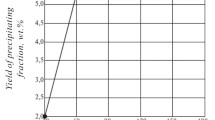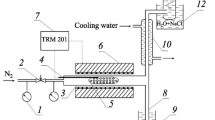Conclusions
-
1.
The molecular weights of the asphaltenes from the Arlansk petroleum, and their chromatographic fractions, were determined by the method of the thermoelectric measurement of vapor pressure (or gas phase osmometry). The method permits making the measurements under conditions which exclude aggregation of asphaltene molecules. Use of a liquid solvent eliminates errors arising from the properties of solid solutions. Determination of the temperatures by means of high-sensitivity thermistors within 3–5 min makes it possible to obtain the results rapidly, with good reproducibility.
-
2.
It is shown that the separation of asphaltenes into fractions of different molecular weights can be accomplished by precipitation chromatography on aluminum oxide. The comparatively low value of the molecular weight obtained for fraction 8, produced by benzene, is attributed to the chemical composition of the compounds in the fraction.
Similar content being viewed by others
Literature cited
S. R. Sergienko, High Molecular Compounds in Petroleum [in Russian], Izd. Khimiya (1964), p. 498.
E. A. Bekturov, Z. Kh. Kemeleva, V. G. Gutsalyuk, and S. R. Rafikov, Tr. Inst. Khim. Nauk, Akad. Nauk KazanSSR,11, 145 (1964).
E. A. Bekturov, Z. Kh. Kemeleva, and K. B. Musabekov, Izv. Akad. Nauk KazanSSR, Ser. Khim., 3rd Ed., 37 (1965).
G. W. Eckert and B. J. Weetman, Ind. Eng. Chem.,39, No. 11 (1947).
I. P. Pfeiffer, The Properties of Asphaltic Bitumen (1950), p. 35.
N. I. Lyashkevich, Neftekhimiya,11, No. 5 (1962).
E. I. Sdobnov, V. G. Gutsalyuk, and É. A. Yatsenko, Khim. i Tekhnol. Topliv i Masel, No. 10 (1964).
K. H. Altgelf, J. Appl. Polymer Sci.,9 (1965).
W. R. Moore and B. M. Tidswell, Chem. Ind., No. 2 (1961).
H. J. Neumann and F. Bellstedt, Erdöl und Kohle, No. T-10 (1966).
A. V. Hill, Proc. Roy. Soc. London, A-127, 9 (1930).
D. E. Burge, J. Phys. Chem.,67 (1963).
C. Tomlinson, C. Chylewski, and W. Simon, Tetrahedron,19, 949 (1963).
J. van Dam, Rec. des Trav. Chim. des Pays-Bas,83, 129 (1964).
R. H. Müller and H. J. Stolen, Anal. Chem.,25 (1953).
J. J. Neumayer, Anal. Chim. Acta,20, No. 6 (1959).
C. A. Baker and R. J. Williams, J. Chem. Soc., No. 5 (1956).
Author information
Authors and Affiliations
Additional information
Translated from Khimiya i Tekhnologiya Topliv i Masel, No. 10, pp. 58–61, October, 1968.
Rights and permissions
About this article
Cite this article
Ratovskaya, A.A. Determination of the molecular weight of asphaltenes by the thermoelectric technique. Chem Technol Fuels Oils 4, 773–776 (1968). https://doi.org/10.1007/BF00723130
Issue Date:
DOI: https://doi.org/10.1007/BF00723130




